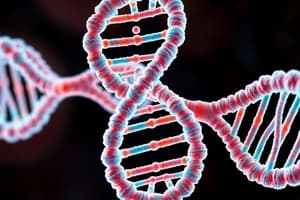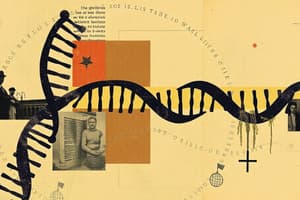Podcast
Questions and Answers
What type of mutation accounts for 30% of human disease-causing mutations?
What type of mutation accounts for 30% of human disease-causing mutations?
- Missense mutation
- Nonsense mutation (correct)
- Frameshift mutation
- Deletion mutation
Which of the following best describes missense mutations?
Which of the following best describes missense mutations?
- They alter the amino acid sequence of a protein. (correct)
- They create internal nonsense codons.
- They lead to no change in the protein sequence.
- They trigger rapid decay of mRNA.
Which characteristic is not associated with β-thalassemia?
Which characteristic is not associated with β-thalassemia?
- Jaundice
- Weakness
- Increased hemoglobin synthesis (correct)
- Frequent blood transfusions
What effect do base analogs have during nucleic acid biosynthesis?
What effect do base analogs have during nucleic acid biosynthesis?
What gene is primarily affected by mutations causing β-thalassemia?
What gene is primarily affected by mutations causing β-thalassemia?
Which of the following describes the impact of UV rays on DNA?
Which of the following describes the impact of UV rays on DNA?
How do nonsense mutations affect mRNA?
How do nonsense mutations affect mRNA?
What type of mutation is primarily caused by intercalating agents?
What type of mutation is primarily caused by intercalating agents?
Which of the following populations is most affected by β-thalassemia?
Which of the following populations is most affected by β-thalassemia?
How do alkylating agents contribute to mutations?
How do alkylating agents contribute to mutations?
What type of mutation is associated with a single base-pair change in human genes?
What type of mutation is associated with a single base-pair change in human genes?
Which type of mutation alters the protein sequence and leads to the creation of internal nonsense codons?
Which type of mutation alters the protein sequence and leads to the creation of internal nonsense codons?
Which type of radiation transforms stable molecules into free radicals?
Which type of radiation transforms stable molecules into free radicals?
What is a common consequence of mutations in the HBB gene?
What is a common consequence of mutations in the HBB gene?
What is a consequence of pyrimidine dimers formed by UV rays?
What is a consequence of pyrimidine dimers formed by UV rays?
What type of mutation does not result in a change in the protein it encodes?
What type of mutation does not result in a change in the protein it encodes?
What type of mutation introduces a stop codon into the protein coding sequence?
What type of mutation introduces a stop codon into the protein coding sequence?
Which mutation results in a codon that codes for a different amino acid?
Which mutation results in a codon that codes for a different amino acid?
What is a characteristic of a frameshift mutation?
What is a characteristic of a frameshift mutation?
What defines a null mutation?
What defines a null mutation?
Which type of mutation occurs when a purine replaces a pyrimidine?
Which type of mutation occurs when a purine replaces a pyrimidine?
Where can one explore comprehensive information on human genes and mutations?
Where can one explore comprehensive information on human genes and mutations?
What is the effect of a gain-of-function mutation?
What is the effect of a gain-of-function mutation?
Which type of mutation would likely cause genetic diseases due to its effects?
Which type of mutation would likely cause genetic diseases due to its effects?
Flashcards
Monogenic diseases
Monogenic diseases
Diseases caused by mutations in a single gene.
Single-gene mutation
Single-gene mutation
A change in the DNA sequence of a single gene.
Nonsense mutation
Nonsense mutation
A mutation that creates a premature stop codon, shortening the protein.
Missense mutation
Missense mutation
Signup and view all the flashcards
Frameshift mutation
Frameshift mutation
Signup and view all the flashcards
β-thalassemia
β-thalassemia
Signup and view all the flashcards
β-globin gene
β-globin gene
Signup and view all the flashcards
HBB gene
HBB gene
Signup and view all the flashcards
Gene mutation
Gene mutation
Signup and view all the flashcards
Point mutation
Point mutation
Signup and view all the flashcards
Loss-of-function mutation
Loss-of-function mutation
Signup and view all the flashcards
Gain-of-function mutation
Gain-of-function mutation
Signup and view all the flashcards
Suppressor mutation
Suppressor mutation
Signup and view all the flashcards
Base analog
Base analog
Signup and view all the flashcards
Alkylating agent
Alkylating agent
Signup and view all the flashcards
Intercalating agent
Intercalating agent
Signup and view all the flashcards
Adduct-forming agent
Adduct-forming agent
Signup and view all the flashcards
Pyrimidine dimer
Pyrimidine dimer
Signup and view all the flashcards
Ionizing radiation
Ionizing radiation
Signup and view all the flashcards
What are some examples of induced mutations?
What are some examples of induced mutations?
Signup and view all the flashcards
What is the OMIM database?
What is the OMIM database?
Signup and view all the flashcards
Study Notes
Gene Mutation, DNA Repair, and Transposition
- Topic: Gene mutation, DNA repair, and transposition were discussed.
- Central Dogma of Molecular Biology: DNA undergoes transcription to mRNA, which then undergoes translation by ribosomes to create proteins within cells.
Gene Mutation Classification
- Mutation: Any base pair change in DNA alters the nucleotide sequence of an organism's genome. This can occur in somatic cells or germ cells, influencing genetic diversity and evolution.
Classification Based on Molecular Change
- Point Mutation (or Base Substitution): A change of one base pair to another in a DNA molecule.
- Missense Mutation: A nucleotide change within a protein-coding triplet, resulting in a different amino acid.
- Nonsense Mutation: A triplet is changed into a stop codon, leading to protein termination.
- Silent Mutation: A point mutation alters a codon but does not affect the amino acid at that position.
- Neutral Mutation: Mutation occurring in non-coding DNA, with no effect on gene products or expression.
Other Types of Point Mutation
- Transition: A pyrimidine replaces a pyrimidine or a purine replaces a purine.
- Transversion: A purine replaces a pyrimidine or vice versa.
Classification Based on Molecular Change: Frameshift Mutation
- Frameshift Mutation: Insertion or deletion of one or more nucleotides within a gene.
- Result: Change in subsequent three-letter codons. May lead to a stop codon, halting polypeptide synthesis.
Classification Based on Effect on Function
- Loss-of-Function Mutation: Reduces or eliminates the function of the gene product.
- Null Mutation: Complete loss of function.
- Gain-of-Function Mutation: Codes for a gene product with enhanced or novel functions.
- Suppressor Mutation: A second mutation that reverses or relieves the effects of a previous mutation.
- Intragenic: Suppressor mutation occurs within the same gene.
- Intergenic: Suppressor mutation occurs in a different gene.
Classification Based on Phenotype
- Phenotypic effect classifications: Visible, Nutritional, Biochemical, Behavioral, Regulatory, Lethal, and Conditional.
- Examples provided for each classification (ranging from Mendel's peas to specific human diseases and animal traits).
- Example of conditional mutation: Shown in Himalayan rabbits.
Mutations Occur Spontaneously and Randomly
- Spontaneous Mutation: Changes in nucleotide sequence occurring naturally, not associated with specific agents.
- Example: DNA replication.
Mutation Rate
- Rate of spontaneous mutation is typically low but varies between organisms and even between genes within the same species.
Spontaneous Mutations Arise from Replication Errors
- DNA Replication Errors: DNA polymerase may insert incorrect nucleotides during replication. It has 3’ to 5’ exonuclease activity which allows for proofreading.
- Tautomers: Bases that increase the chance of mispairing during DNA replication.
Spontaneous Mutations (Examples)
- Depurination: Loss of a nitrogenous base in DNA, commonly guanine or adenine.
- Deamination: Conversion of an amino group to a keto group, with cytosine converted to uracil and adenine to hypoxanthine.
- Oxidative Damage: Reactive oxygen species (free radicals) that create DNA chemical modifications and sometimes damage.
- Jumping Genes (Transposable Elements): These elements can cause mutations when moving within a genome.
Induced Mutations
- Induced Mutation: Resulting from exogenous (external) factors such as UV radiation (example given of skin cancer).
Examples of Induced Mutations
- Base Analogs
- Alkylating Agents
- Intercalating Agents
- Adduct-Forming Agents
- Ultraviolet (UV) Rays
- Ionizing Radiation
Single-Gene Mutation and Human Diseases
- Monogenic Diseases: Diseases caused by mutations in a single gene.
- OMIM (Online Mendelian Inheritance in Man): A database of human genes, mutations, and disorders.
Single-Gene Mutation and Diseases: Point Mutations
- Point Mutations: Mutations involving specific nucleotide changes, including missense and nonsense mutations
- Missense; results in aa substitution.
- Nonsense; a stop codon substitutes for an aa.
- Frameshift; Involves deletions or insertions of nucleotides that alter the sequence's reading frame.
Single-Gene Mutation and Diseases: Other Types
- Beta-thalassemia: caused by mutations in the beta-globin gene and can result in a decrease in red blood cells and oxygen delivery to the body.
Expandable DNA Repeats
- Expansion of trinucleotide repeats in some mutant genes.
- Disorders linked to trinucleotide repeat expansion: Fragile X syndrome, Myotonic dystrophy, and Huntington's disease
- Trinucleotide Repeat Expansios: Causes conditions like intellectual disability and muscle/neurological problems.
DNA Repair Systems
- Living systems have evolved sophisticated repair systems to counteract spontaneous and induced DNA damage, ensuring genetic integrity.
- Mentioned scientists who received Nobel Prizes for their work on DNA replication and repair.
Proofreading and Mismatch Repair
- DNA polymerase's proofreading capability (3' to 5' exonuclease) catches many errors.
- Mismatch Repair (MMR) mechanism deals with errors that occur after proofreading.
Postreplication Repair
- Repair system for DNA damage that has escaped earlier repair steps.
- Role of RecA protein: Directs recombinational exchange to repair gaps.
Photoreactivation Repair
- UV-induced damage can be repaired by visible light using photoreactivation enzymes.
- Thymine dimers: Cross-links caused by UV radiation, disrupted by photoreactivation enzymes which require activation by blue light.
Base and Nucleotide Excision Repair
- DNA repair system to correct damaged or inappropriate bases, involving enzymes to recognize damage sites and remove them.
Xeroderma Pigmentosa (XP)
- Recessive genetic disorder affecting NER pathways. Increased sensitivity to UV radiation; often leading to skin cancer.
Ames Test
- Assay used to determine a chemical compound's mutagenicity. It measures a compound's ability to cause mutations in bacteria.
Transposable Elements (TEs)
- DNA sequences that move within or between chromosomes.
- Types of transposable elements: DNA transposons and retrotransposons.
- Potential to cause mutations if the movement disrupts genes.
Retrotransposons
- A type of TE that expands itself by copying its contents via RNA intermediate, and then inserting that RNA back into the genome as DNA.
- These are not infectious as they don't have other necessary structural components like a retrovirus.
End of Lecture
Studying That Suits You
Use AI to generate personalized quizzes and flashcards to suit your learning preferences.




